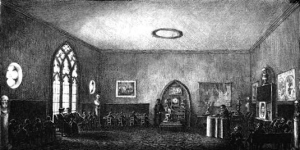From 1826 to early 1833 Margaret lived in Old Cambridge, close to Harvard University. The community in Old Cambridge was predominately Harvard professors, scholars and intellectuals whom Margaret, despite her formal education having ended, found a place among. It was during these years that Margaret met James Freeman Clarke (1810-1888), a recent Harvard graduate who was in his first year of Divinity School. Fuller and Clarke became close friends and together they studied German with hopes of reading the original German texts that they considered foundational in literary Romanticism. Once proficient in German, Fuller began to explore the literature of late eighteenth-century German intellectuals and took great interest in Johann Wolfgang Von Goethe (1749-1832) whose phrase “Das ewig weibliche zieht uns hinan” (The ever womanly draws us forward) influenced the development of her feminist thinking. Fuller’s interest in German and Goethe led to the publication of her first book in 1839, an English translation of the first two parts of Johann Pater Eckermann’s Conversations with Goethe in the Last Years of His Life (1836). During this time Fuller prepared to write the biography of Goethe but the task was never completed. Margaret and her dear friend James F. Clarke maintained frequent correspondence, often discussing their ideas regarding Goethe’s writing:
It seems to me as if the mind of Goethe had embraced the universe – I have felt so much lately in reading his lyrick poems – I am enchanted while I read; he comprehends every feeling I ever had so perfectly, expresses it so beautifully, but when I shut the book, it seems as if I had lost my personal identity – All my feelings linked with such an immense variety that belong to beings I had thought so different. What can I bring? (Margaret Fuller to James F. Clarke, 7 August, 1832).
Margaret’s old schoolteacher from Dr. Park’s Boston school, Elizabeth Peabody, took interest in Margaret’s writing and as editor of American Monthly Magazine published three of Fuller’s literary critic essays in the spring of 1836. Elizabeth also arranged for Fuller to stay with Ralph Waldo Emerson; the visit would be her first personal encounter with the revered lecturer, essayist, and prominent transcendental figure. During her stay with Emerson, Fuller met Amos Bronson Alcott (1799-1888) who offered her an assisting position at the Temple School in Boston. The Temple School was open from 1834 to 1838 and became representative of the Transcendentalist ideals regarding educational reform. In 1837 Fuller left the Temple School and negotiated a contract with Hiram Fuller of the Greene Street School in Providence, Rhode Island where she was promised a yearly salary of $1,000.

Leading up to the opening of the Greene Street School, Margaret stayed with the Emerson’s multiple times. Margaret had hoped to meet Emerson for years before her first visit with him in the summer of 1836. Having been a social and intellectual misfit for most of her life, Margaret was drawn to the Transcendental ideals that Emerson gave public lectures on. Margaret’s Divinity School friends, including James F. Clarke and Henry Hedge, had become highly interested in Emerson when he resigned from an esteemed Boston pulpit when the congregation would not allow him to disregard the ritual of communion like he wished to. Margaret had expressed interest in meeting Emerson as early as 1834. In a letter to Frederic H. Hedge (Henry), Margaret makes the case for her friend to send one of her Goethe translations to Emerson:
With regard to Mr Emerson, I had two reasons (if they may deserve to be so called) for wishing him to see my Tasso. It gratified me that a mind which had affected mine so powerfully should be dwelling on something of mine even though ‘twere only new dress for the thoughts of another – And I thought he might express something which would be useful to me. I should like very much his corrections as well as yours if it be not too much trouble. (30 November, 1834)
Hedge sent the manuscript of Tasso to Emerson and it was received well. After reading it, Emerson decided that he wanted to know Margaret Fuller and they began a correspondence that led to Fuller’s frequent stays at the Emerson home. Their friendship intensified and the nature of their relationship seemed, especially in the early years, confused at times. Nevertheless, Fuller and Emerson held each other in the highest regard. Throughout their friendship, which lasted the rest of Fuller’s life and remained at the forefront of Emerson’s mind after her death, the two discussed and exchanged countless literary, ideological, and transcendental ideas.
In the year after her first stay with Emerson, Margaret attended a few of the Transcendental Club meetings. In 1839, the Transcendental Club decided to created a quarterly journal called The Dial: A Magazine for Literature, Philosophy, and Religion which was first published in July of 1840 and continued until April of 1844. Not only did Margaret edit the first eight publications alongside Emerson, but she contributed a significant amount of her own writing to the journal. Appearing in the first publication of The Dial (July 1840) was Thoreau’s poem “Sympathy” and a prose essay titled “Aulus Persius Flaccus.” The publication came less than two weeks before Thoreau’s twenty-third birthday and was the first time his writing had appeared in print.

